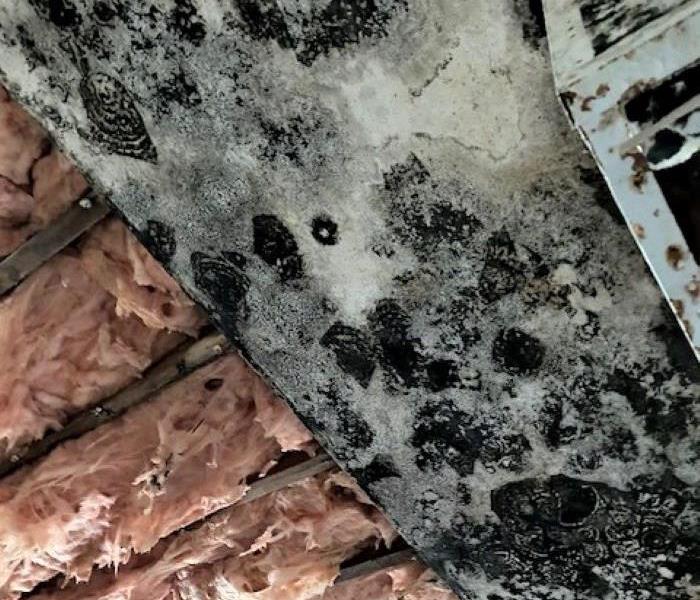Understanding Mold Remediation: A Vital Step Towards a Healthy Home
6/24/2024 (Permalink)
Mold is a common household nuisance that, if left unchecked, can pose serious health risks and compromise the structural integrity of your home. Whether it's a result of water damage, high humidity, or inadequate ventilation, mold growth demands prompt attention and professional remediation.
What is Mold Remediation?
Mold remediation is the process of identifying, containing, and eliminating mold infestations in homes and buildings. It goes beyond simply cleaning visible mold; it involves addressing the root cause of the issue to prevent recurrence. This meticulous process requires expertise and specialized equipment to ensure thoroughness and effectiveness.
Why Choose SERVPRO® for Mold Remediation?
SERVPRO is a leading provider of mold remediation services, known for our meticulous approach and commitment to customer satisfaction. Here’s why we stand out:
1.Expertise and Experience: SERVPRO technicians are trained in advanced mold remediation techniques and adhere to industry standards. We understand the complexities of mold growth and are equipped to handle any scale of contamination.
2. Comprehensive Assessment: Before starting remediation, we conduct a thorough inspection to assess the extent of mold damage and identify the source of moisture. This step is crucial for developing a tailored remediation plan.
3. Effective Containment: To prevent mold spores from spreading to unaffected areas, SERVPRO uses advanced containment measures. This includes setting up barriers and negative air pressure to isolate the contaminated area.
4. Safe Removal and Cleaning: Using specialized equipment and EPA-approved cleaning products, SERVPRO removes mold colonies safely and effectively. We ensure that all affected materials are properly cleaned or removed to prevent future growth.
5. Prevention Strategies: Beyond remediation, our team offers recommendations to prevent mold recurrence. This may include improving ventilation, addressing leaks, or installing dehumidifiers to maintain optimal humidity levels.
Don’t let mold compromise your home’s safety and comfort. If you suspect mold growth or have experienced water damage, don’t hesitate to contact SERVPRO for professional mediation services.
Where does mold grow in Connecticut homes?
4/11/2022 (Permalink)
Mold spores naturally exist in all interior and exterior environments and at normal levels, are not harmful. Given the opportunity, however, mold spores can grow quickly and reach dangerously high levels. Most people are aware of the health concerns that are associated with mold in the home and know to keep an eye out for mold growth in their showers and basements. There are some surprising places that mold can grow in the home and business where it's appearance isn't quite as apparent.
- Ceiling tiles – Many businesses choose to have dropped ceiling tiles installed due to the ease of access to the plumbing, fixtures and ductwork above them. In residential homes, ceiling tiles are often found in a finished basement. The lack of light and moisture from pipes and ducts, along with the obscurity of being hidden behind the ceiling, makes the space above your dropped ceiling ideal for mold growth. If you notice staining on your ceiling tiles, take them out and investigate the source of water. Once the leak has been repaired, replace any affected tiles.
- Under your area rugs and floor mats – Most homes and businesses have mats at the front entrance so that those entering can wipe their feet. But the rain, snow and mud that is shaken off boots saturates the rugs, creating a breeding ground for mold. Be sure to pick lift rugs, clean them and allow them to dry out on a regular basis to deter mold from growing.
- Behind the kitchen sink – We do several mold remediation jobs each year in which mold was discovered behind (or under) a kitchen sink. The culprit is typically a slow leaking pipe that goes unnoticed because of its location. The water damage is eventually discovered – sometimes because the cabinetry is rotting, other times due to kitchen renovation – and substantial mold growth along with it. If you notice any signs of leaking water under your sink such as discoloration of the cabinets or lifting of the flooring around the sink, call a plumber in to determine and repair the cause.
- HVAC system – Mold grows in ductwork because of the condensation that can build up due to the moist air blowing through them. HVAC ducts also collect organic material such as dust, pollen, animal fur and dead skin cells. This material happens to be an excellent source of food for mold spores. Typically, a musty odor is the first sign people notice that there may be mold in their ducts. Having your HVAC system cleaned annually will reduce the risk of mold growth by removing these particles.
- Your attic – Moisture in your attic can cause mold to grow. This can occur for a variety of reasons, the most obvious being a small, undetected roof leak. However, mold growth is also caused when an attic has inadequate or improperly installed venting. Additionally, air leaks in the attic allow warm, moist air to enter the space as well. Air leaks can be caused by a variety of reasons- the space around the chimney, the furnace vent and even cable and electrical lines entering the home.
The SERVPRO of Shelton, Naugatuck team specializes in mold damage remediation. Our mold specialists have over 30 years of experience identifying and treating homes and businesses that have mold infestations in the Connecticut.



 24/7 Emergency Service
24/7 Emergency Service

